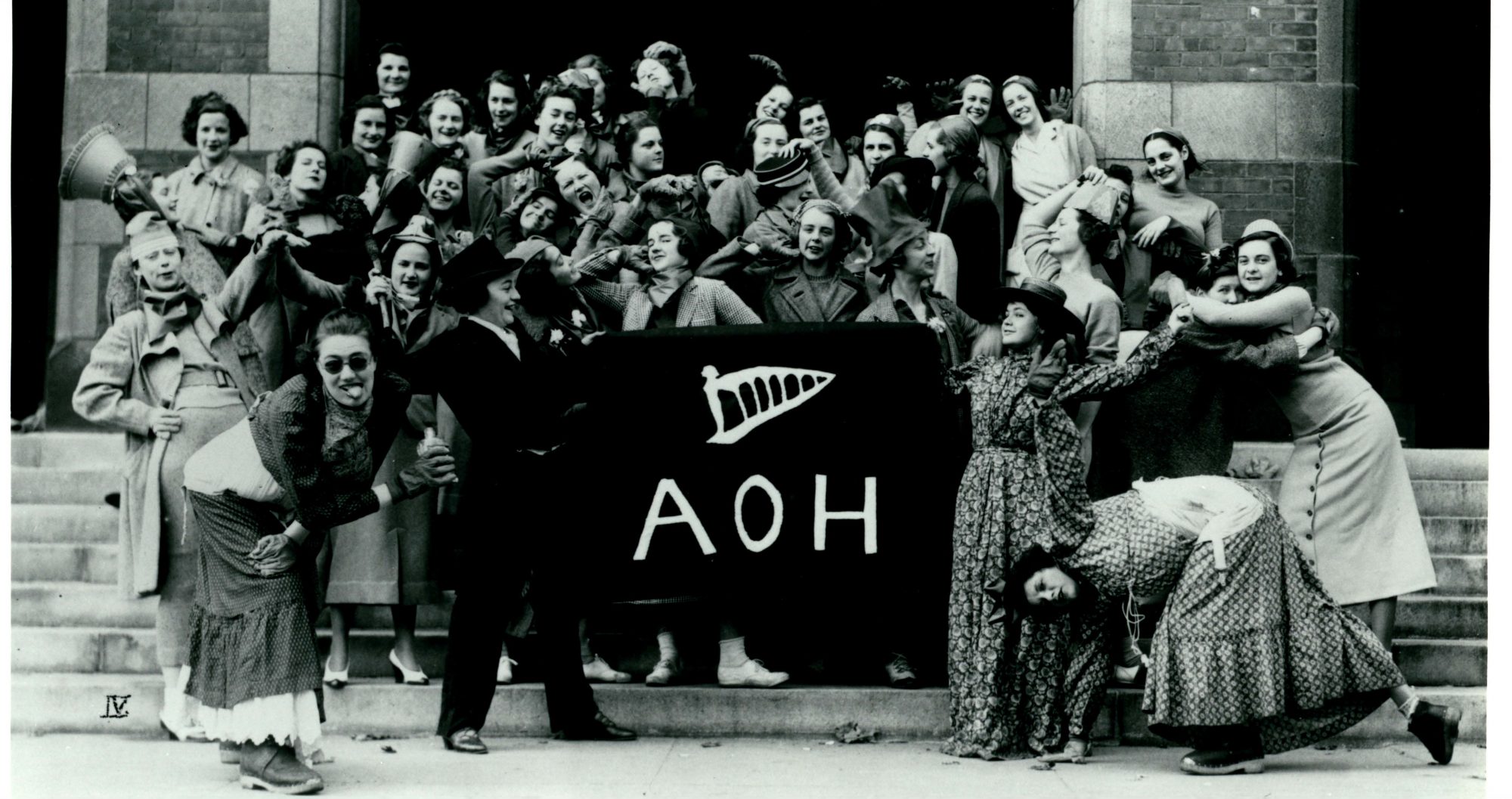Note: the following section contains discussions of the history of the Ku Klux Klan at Smith College. I am aware that this may be an upsetting history for different people based on past experiences of discrimination, oppression, and white supremacist violence. I have included this history because it should not be glossed over, however I do not wish to recreate or perpetuate harm based in histories and legacies of white supremacy and violence. While I reference an image related to the KKK, I do not show it. Please see the footnotes for further information.
In 1954, Marcia Damon wrote “Membership In Hooded Society Insignificant Honor At Smith” in Smith College Associated News in which she lists secret societies that have existed at Smith College in the past. In this, she included Ku Klux Klan as a secret society.1 In 1907, the Ku Klux Klan appeared in the Smith College yearbook. They never appeared again.2
This has puzzled archivists and others at Smith. White supremacy most certainly existed and exists at Smith College as it is deeply embedded in the rest of our society. However, the appearance of the Klan in just 1907 is confusing as a year. Because, the Klan had faded after reconstruction and did not resurge until 1915.3 Linda Gordon describes the Klan as a “secret fraternity with the aim of reimposing servitude on African Americans after the end of slavery… It had never entirely disappeared, but faded somewhat after achieving its goal: electoral disenfranchisement and economic subjugation of black people.”4.
Susan Grant Rosen hypothesized that students might have read the 1905 book The Clansmen: An Historical Romance of the Ku Klux Klan by Thomas W. Dixon or the 1902 play The Leopard’s Spot. Thomas Dixon also wrote the play, The Clansmen, which became the basis for Birth of a Nation by D.W. Griffith. The Leopard’s Spot and the book The Clansmen were both held in Neilson library.5 Another archivist, Kathleen Nutter also hypothesized that the students learned about Dixon’s works and about the KKK from a professor from the South, George W. Cable who was also the founder of the People’s Institute.6 The intentions of this group are not obvious to the archivists. Rosen also postulated that the group could have emerged solely from racism and racist intentions or was “satire mixed with racial insensitivity.”7 The group when it appeared had 17 members.8 There was another secret society at Smith for a longer amount of time called GD whose leader was the “Ku Ku Commander in Goo,” which Rosen mentions, but does not have an answer for.9 While Rosen can trace where knowledge of the KKK came from to reach these students, she does not know how they came to create a group and be featured as an organization in the yearbook.10
This is relevant to the history of the A.O.H. and Orangemen because there was overlap in their membership. All of the members of the KKK at Smith were not from the South. They were Methodist, Episcopal, Christian Scientist, Unitarian, Baptist, and Congregational.11 13 out of 17 of the KKK members were part of the A.O.H. or Orangemen. 8 of the KKK members were also in A.O.H. and 6 of the KKK members were in Orangemen.12
Footnotes
- Marcia Damon, “Membership In Hooded Society Insignificant Honor At Smith,” Smith College Associated News (SCAN), November 6, 1954, Secret Societies, 1951, Student Clubs and Organizations records, Box #3004.6, Smith College Archives, CA-MS-00022, Smith College Special Collections, Northampton, Massachusetts. ↩
- “Ku Klux Klan, 1907,” Smith College Finding Aids, accessed April 28, 2022, https://findingaids.smith.edu/repositories/4/archival_objects/14802. ↩
- “Ku Klux Klan, 1907.” ↩
- Linda Gordon, The Second Coming of the KKK: The Ku Klux Klan of the 1920s and the American Political Tradition (New York and London: Liveright, 2017), 2 ↩
- “Ku Klux Klan, 1907.” ↩
- “Ku Klux Klan, 1907.” ↩
- “Ku Klux Klan, 1907.” ↩
- “Ku Klux Klan, 1907.” ↩
- Susan Grant Rosen, “Why a ‘Ku Klux Klan’ Club at Smith College in 1907?” July 1988, Ku Klux Klan, Student Clubs and Organizations Records, Smith College Archives, Smith College Special Collections, Northampton, Massachusetts. ↩
- Rosen, “Why a ‘Ku Klux Klan’ Club at Smith College in 1907?” ↩
- “Ku Klux Klan Members Listed in 1907 Yearbook,” Ku Klux Klan, Student Clubs and Organizations Records, Smith College Archives, Smith College Special Collections, Northampton, Massachusetts. ↩
- Smith College, Class of 1907 Classbook (Smith College, 1907), 86, 87, 90, https://archive.org/details/class1907smit/page/n1/mode/2up. Note: Page 90 contains an illustration of a KKK hooded robe. I have chosen to not show this page or image here as to not recreate harm or give this image a platform on this website. It is publicly accessible and digitized on the Internet Archive site, should you choose to view it. ↩
